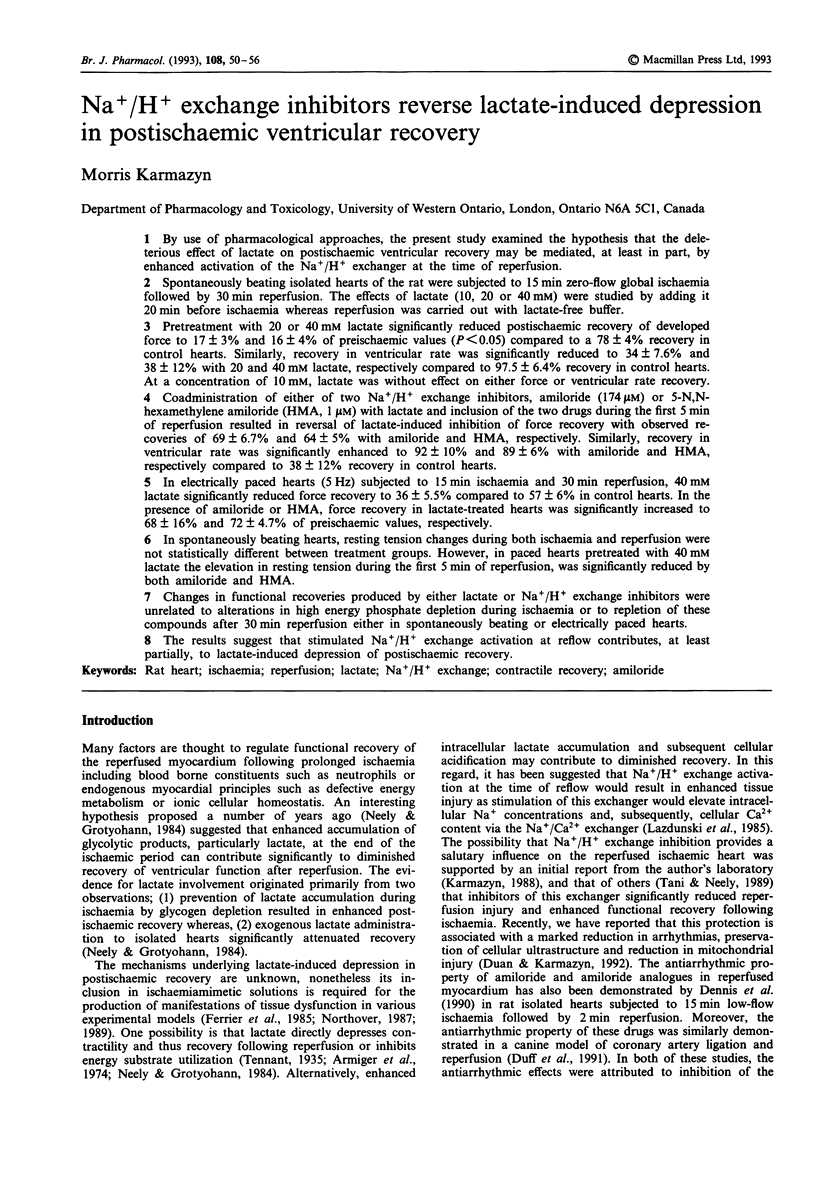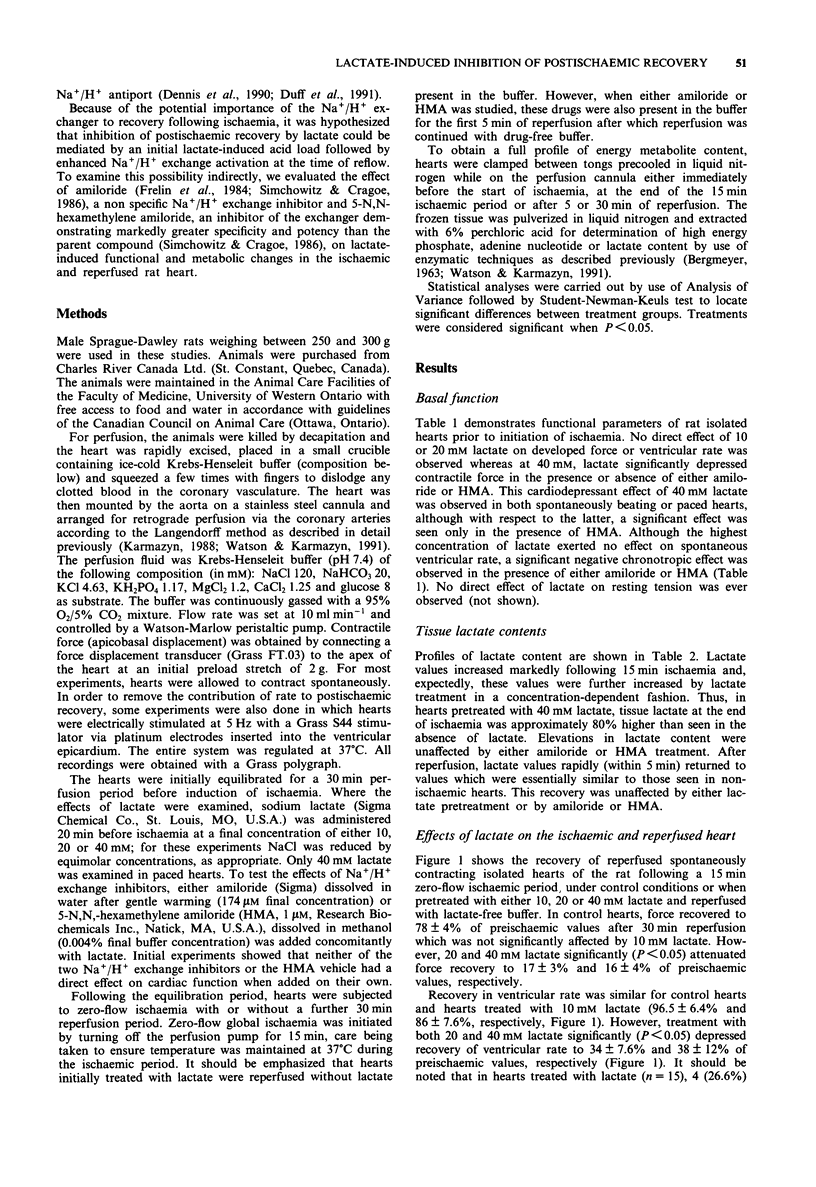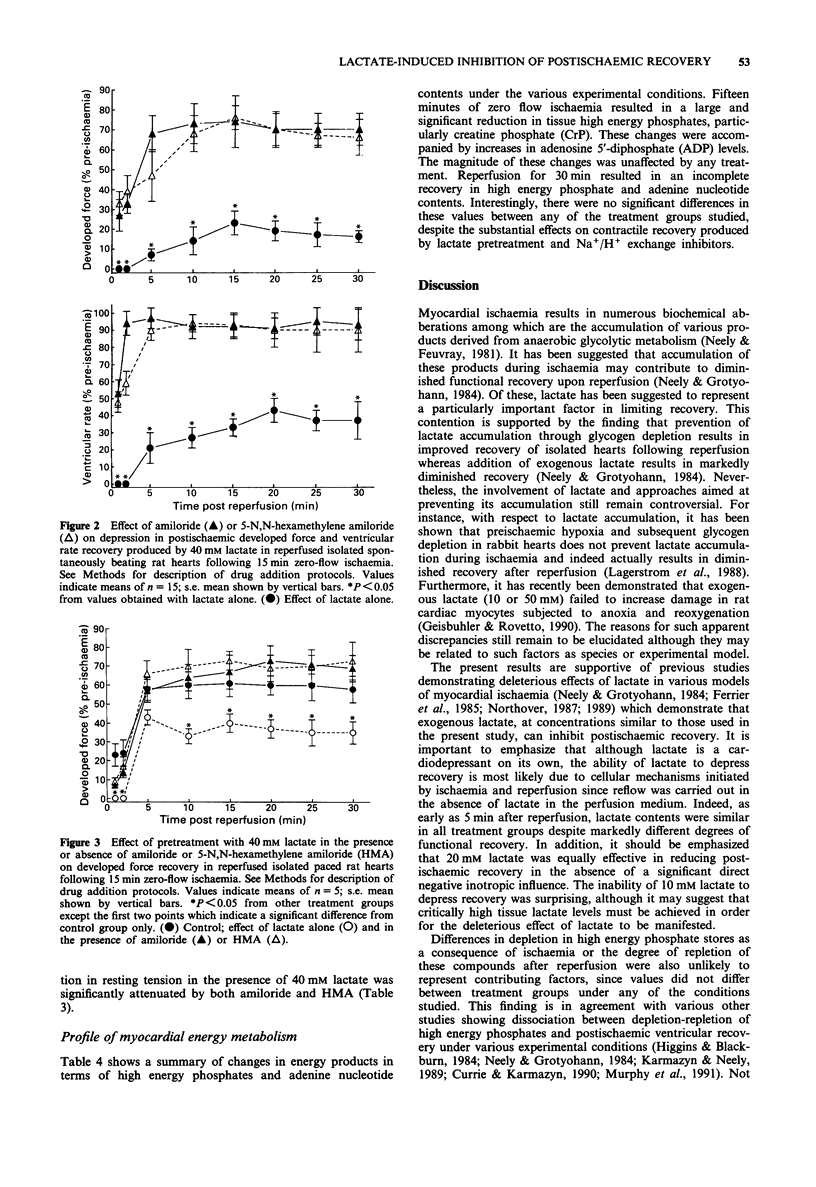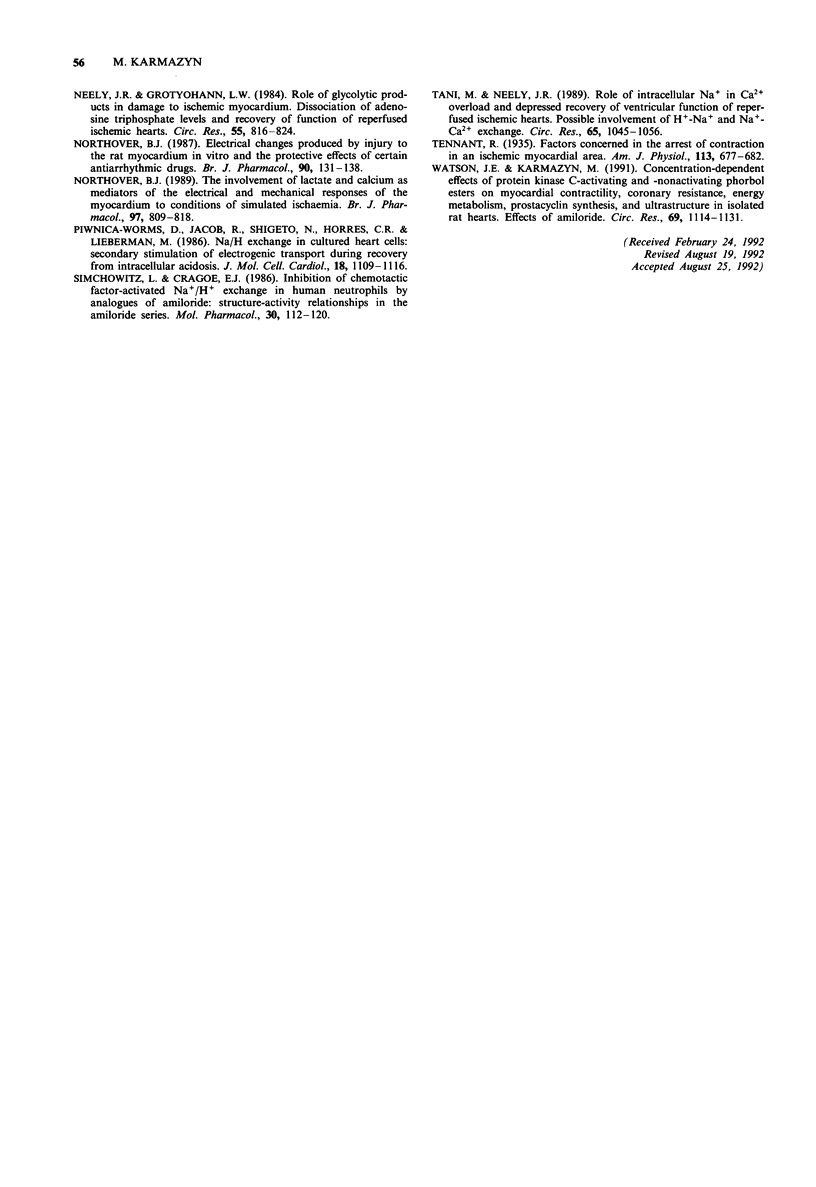Abstract
1. By use of pharmacological approaches, the present study examined the hypothesis that the deleterious effect of lactate on postischaemic ventricular recovery may be mediated, at least in part, by enhanced activation of the Na+/H+ exchanger at the time of reperfusion. 2. Spontaneously beating isolated hearts of the rat were subjected to 15 min zero-flow global ischaemia followed by 30 min reperfusion. The effects of lactate (10, 20 or 40 mM) were studied by adding it 20 min before ischaemia whereas reperfusion was carried out with lactate-free buffer. 3. Pretreatment with 20 or 40 mM lactate significantly reduced postischaemic recovery of developed force to 17 +/- 3% and 16 +/- 4% of preischaemic values (P < 0.05) compared to a 78 +/- 4% recovery in control hearts. Similarly, recovery in ventricular rate was significantly reduced to 34 +/- 7.6% and 38 +/- 12% with 20 and 40 mM lactate, respectively compared to 97.5 +/- 6.4% recovery in control hearts. At a concentration of 10 mM, lactate was without effect on either force or ventricular rate recovery. 4. Coadministration of either of two Na+/H+ exchange inhibitors, amiloride (174 microM) or 5-N,N-hexamethylene amiloride (HMA, 1 microM) with lactate and inclusion of the two drugs during the first 5 min of reperfusion resulted in reversal of lactate-induced inhibition of force recovery with observed recoveries of 69 +/- 6.7% and 64 +/- 5% with amiloride and HMA, respectively. Similarly, recovery in ventricular rate was significantly enhanced to 92 +/- 10% and 89 +/- 6% with amiloride and HMA, respectively compared to 38 +/- 12% recovery in control hearts.(ABSTRACT TRUNCATED AT 250 WORDS)
Full text
PDF






Selected References
These references are in PubMed. This may not be the complete list of references from this article.
- Armiger L. C., Gavin J. B., Herdson P. B. Mitochondrial changes in dog myocardium induced by neutral lactate in vitro. Lab Invest. 1974 Jul;31(1):29–33. [PubMed] [Google Scholar]
- Currie R. W., Karmazyn M. Improved post-ischemic ventricular recovery in the absence of changes in energy metabolism in working rat hearts following heat-shock. J Mol Cell Cardiol. 1990 Jun;22(6):631–636. doi: 10.1016/0022-2828(90)91006-s. [DOI] [PubMed] [Google Scholar]
- Dennis S. C., Coetzee W. A., Cragoe E. J., Jr, Opie L. H. Effects of proton buffering and of amiloride derivatives on reperfusion arrhythmias in isolated rat hearts. Possible evidence for an arrhythmogenic role of Na(+)-H+ exchange. Circ Res. 1990 Apr;66(4):1156–1159. doi: 10.1161/01.res.66.4.1156. [DOI] [PubMed] [Google Scholar]
- Dennis S. C., Kohn M. C., Anderson G. J., Garfinkel D. Kinetic analysis of monocarboxylate uptake into perfused rat hearts. J Mol Cell Cardiol. 1985 Oct;17(10):987–995. doi: 10.1016/s0022-2828(85)80079-1. [DOI] [PubMed] [Google Scholar]
- Duan J., Karmazyn M. Protective effects of amiloride on the ischemic reperfused rat heart. Relation to mitochondrial function. Eur J Pharmacol. 1992 Jan 14;210(2):149–157. doi: 10.1016/0014-2999(92)90665-q. [DOI] [PubMed] [Google Scholar]
- Duff H. J., Brown C. E., Cragoe E. J., Rahmberg M. Antiarrhythmic activity of amiloride: mechanisms. J Cardiovasc Pharmacol. 1991 Jun;17(6):879–888. doi: 10.1097/00005344-199106000-00004. [DOI] [PubMed] [Google Scholar]
- Ferrier G. R., Moffat M. P., Lukas A. Possible mechanisms of ventricular arrhythmias elicited by ischemia followed by reperfusion. Studies on isolated canine ventricular tissues. Circ Res. 1985 Feb;56(2):184–194. doi: 10.1161/01.res.56.2.184. [DOI] [PubMed] [Google Scholar]
- Floreani M., Tessari M., Debetto P., Luciani S., Carpenedo F. Effects of N-chlorobenzyl analogues of amiloride on myocardial contractility, Na-Ca-exchange carrier and other cardiac enzymatic activities. Naunyn Schmiedebergs Arch Pharmacol. 1987 Dec;336(6):661–669. doi: 10.1007/BF00165758. [DOI] [PubMed] [Google Scholar]
- Frelin C., Vigne P., Lazdunski M. The role of the Na+/H+ exchange system in cardiac cells in relation to the control of the internal Na+ concentration. A molecular basis for the antagonistic effect of ouabain and amiloride on the heart. J Biol Chem. 1984 Jul 25;259(14):8880–8885. [PubMed] [Google Scholar]
- Geisbuhler T. P., Rovetto M. J. Lactate does not enhance anoxia/reoxygenation damage in adult rat cardiac myocytes. J Mol Cell Cardiol. 1990 Nov;22(11):1325–1335. doi: 10.1016/0022-2828(90)90068-d. [DOI] [PubMed] [Google Scholar]
- Higgins A. J., Blackburn K. J. Prevention of reperfusion damage in working rat hearts by calcium antagonists and calmodulin antagonists. J Mol Cell Cardiol. 1984 May;16(5):427–438. doi: 10.1016/s0022-2828(84)80614-8. [DOI] [PubMed] [Google Scholar]
- Kaibara M., Kameyama M. Inhibition of the calcium channel by intracellular protons in single ventricular myocytes of the guinea-pig. J Physiol. 1988 Sep;403:621–640. doi: 10.1113/jphysiol.1988.sp017268. [DOI] [PMC free article] [PubMed] [Google Scholar]
- Karmazyn M. Amiloride enhances postischemic ventricular recovery: possible role of Na+-H+ exchange. Am J Physiol. 1988 Sep;255(3 Pt 2):H608–H615. doi: 10.1152/ajpheart.1988.255.3.H608. [DOI] [PubMed] [Google Scholar]
- Karmazyn M., Neely J. R. Inhibition of post-ischemic ventricular recovery by low concentrations of prostacyclin in isolated working rat hearts: dependency on concentration, ischemia duration, calcium and relationship to myocardial energy metabolism. J Mol Cell Cardiol. 1989 Mar;21(3):335–346. doi: 10.1016/0022-2828(89)90749-9. [DOI] [PubMed] [Google Scholar]
- Lagerstrom C. F., Walker W. E., Taegtmeyer H. Failure of glycogen depletion to improve left ventricular function of the rabbit heart after hypothermic ischemic arrest. Circ Res. 1988 Jul;63(1):81–86. doi: 10.1161/01.res.63.1.81. [DOI] [PubMed] [Google Scholar]
- Lazdunski M., Frelin C., Vigne P. The sodium/hydrogen exchange system in cardiac cells: its biochemical and pharmacological properties and its role in regulating internal concentrations of sodium and internal pH. J Mol Cell Cardiol. 1985 Nov;17(11):1029–1042. doi: 10.1016/s0022-2828(85)80119-x. [DOI] [PubMed] [Google Scholar]
- Mann G. E., Zlokovic B. V., Yudilevich D. L. Evidence for a lactate transport system in the sarcolemmal membrane of the perfused rabbit heart: kinetics of unidirectional influx, carrier specificity and effects of glucagon. Biochim Biophys Acta. 1985 Oct 10;819(2):241–248. doi: 10.1016/0005-2736(85)90179-8. [DOI] [PubMed] [Google Scholar]
- Murphy E., Perlman M., London R. E., Steenbergen C. Amiloride delays the ischemia-induced rise in cytosolic free calcium. Circ Res. 1991 May;68(5):1250–1258. doi: 10.1161/01.res.68.5.1250. [DOI] [PubMed] [Google Scholar]
- Neely J. R., Feuvray D. Metabolic products and myocardial ischemia. Am J Pathol. 1981 Feb;102(2):282–291. [PMC free article] [PubMed] [Google Scholar]
- Neely J. R., Grotyohann L. W. Role of glycolytic products in damage to ischemic myocardium. Dissociation of adenosine triphosphate levels and recovery of function of reperfused ischemic hearts. Circ Res. 1984 Dec;55(6):816–824. doi: 10.1161/01.res.55.6.816. [DOI] [PubMed] [Google Scholar]
- Northover B. J. Electrical changes produced by injury to the rat myocardium in vitro and the protective effects of certain antiarrhythmic drugs. Br J Pharmacol. 1987 Jan;90(1):131–138. doi: 10.1111/j.1476-5381.1987.tb16832.x. [DOI] [PMC free article] [PubMed] [Google Scholar]
- Northover B. J. The involvement of lactate and calcium as mediators of the electrical and mechanical responses of the myocardium to conditions of simulated ischaemia. Br J Pharmacol. 1989 Jul;97(3):809–818. doi: 10.1111/j.1476-5381.1989.tb12020.x. [DOI] [PMC free article] [PubMed] [Google Scholar]
- Piwnica-Worms D., Jacob R., Shigeto N., Horres C. R., Lieberman M. Na/H exchange in cultured chick heart cells: secondary stimulation of electrogenic transport during recovery from intracellular acidosis. J Mol Cell Cardiol. 1986 Nov;18(11):1109–1116. doi: 10.1016/s0022-2828(86)80036-0. [DOI] [PubMed] [Google Scholar]
- Simchowitz L., Cragoe E. J., Jr Inhibition of chemotactic factor-activated Na+/H+ exchange in human neutrophils by analogues of amiloride: structure-activity relationships in the amiloride series. Mol Pharmacol. 1986 Aug;30(2):112–120. [PubMed] [Google Scholar]
- Tani M., Neely J. R. Role of intracellular Na+ in Ca2+ overload and depressed recovery of ventricular function of reperfused ischemic rat hearts. Possible involvement of H+-Na+ and Na+-Ca2+ exchange. Circ Res. 1989 Oct;65(4):1045–1056. doi: 10.1161/01.res.65.4.1045. [DOI] [PubMed] [Google Scholar]
- Watson J. E., Karmazyn M. Concentration-dependent effects of protein kinase C-activating and -nonactivating phorbol esters on myocardial contractility, coronary resistance, energy metabolism, prostacyclin synthesis, and ultrastructure in isolated rat hearts. Effects of amiloride. Circ Res. 1991 Oct;69(4):1114–1131. doi: 10.1161/01.res.69.4.1114. [DOI] [PubMed] [Google Scholar]


